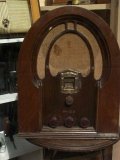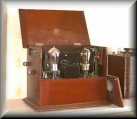Music
Key terms: underscoring music, timbre, tone
| Music gives resonance - emotional and dramatic - to a scene. |
| It can suggest character, setting, time and date, mood. |
| It can create a sense of unity across the play. |
| As another domain than dialogue, it interacts with human speech. |
|
It can compensate for the economy of radio, and create spatial depth and detail in the 'mise en scène'. |
| Music has essential elements: rhythm, melody, harmony and tone colour. |
| The rhythm and tempo of music can give an underlying foundation to dialogue, and dialogue must be paced - in studio production - with the music. |
| Each music genre has cultural associations - classical orchestral, 'classical' rock, jazz. CONTEMPORARY CLASSICAL ('plinky-plonky') music is useful for experimental pieces because it has few cultural associations for most listeners beyond being 'art' music, and so is more abstract. This genre enables you to work with more freedom as a sound designer. (You do not have to use it.) |
| Beware of using a music genre that does not fit in - as jazz with a Dracula adaptation.A logic problem. |
CATEGORIES (OR GENRES) OF MUSIC
Extend your knowlege of music by research
| Indiana University School of Music - Worldwide Internet Music Resources - http://www.music.indiana.edu/music_resources/genres.html |
| Music Tutorial - http://www.lib.duke.edu/dw3/SPT--BrowseResources.php?ParentId=755 |
| Music Analysis Glossary - http://www.ltrc.mcmaster.ca/schenkeranalysis/ |
| Fun with music site - http://www.sfskids.org/templates/musiclab.asp?pageid=4 |
| Rhythm explained - http://daniellaberge.com/rhythm/rhythm1.html |
| List of music genres - http://www.answers.com/topic/list-of-music-genres |
|
PROBLEMS WITH CHOOSING MUSIC There is a special problem about music and singing. The sung words (= the lyrics) will almost always fight against the dialogue. It is very difficult to have underscoring music with lyrics under dialogue. Only use underscoring music - for the most part. Sometimes you may want to make a point about a particular song's lyrics being heard under the dialogue. You can do this with care, but make the most of the music breaks (the parts of the song which are musical instruments, without the singer.) See PRE-PRODUCTION - Music signature tune = sig tune (on the Radio Soap site) It's difficult to write about music The difficulty of creating an adequate methodology and the necessity of it in relation to 'the difficulty in verbalising what music subjectively awakens in the listener, the utter obscurity of what is blithely called "the lived experience of music"' (Adorno 1998, p.220). Smith, Bruce R., 1999, The Acoustic World of Early Modern
England, London: University of Chicago Press. Some terms |
| Head tone. The primary melodic note of a composition. It is established near the beginning of a piece, or follows an initial ascent. (from Schenker Music Analysis - http://www.ltrc.mcmaster.ca/schenkeranalysis/HeadTone.htm) |
| Initial ascent. The music of the upper voice at the beginning of a composition that leads via a linear progression from an initial tonic to the Head Tone. |
|
See Filmic - styles of radio drama directing and post-production which creatively relate to film See 'mise-en-scène' - representation of the play scene, locations, spaces and perspectives
In music, timbre is the quality of a musical note which distinguishes different types of musical instrument. For example, a note of the same pitch can be played on several different instruments: it has the same frequency, yet the human ear hears them as different, and with a little practice can identify the instruments involved. The distinctive property of a complex sound (a voice or noise or musical sound); "the timbre of her soprano was rich and lovely"; "the muffled tones of the broken bell summoned them to meet". The way you can distinguish between two sounds although they have the same loudness and pitch. We often describe timbre from the object that produces the sound - as a trumpet - and with an adjective, as shrill. Timbre is a way that we can differentiate between sounds. “Timbre is that attribute of sensation in terms of which a listener can judge that two sounds having the same loudness and pitch are dissimilar” (Phonetics) the distinctive tone quality differentiating one vowel or sonant from another (Music) tone colour or quality of sound, esp. a specific type of tone colour "..that attribute of auditory sensation in terms of which sounds may be ordered on a scale extending from high to low". "..that attribute of auditory sensation in terms of which a listener can judge that two sounds, similarly presented and having the same loudness and pitch, are different". When we as listeners describe timbre, we often specify what something sounds like. This something can either refer to an object that produced the sound – such as a trumpet – or to an adjective used to specify a dominant characteristic of the sound – such as shrill. Timbre refers to the perceptual quality of sounds. Qualities, as opposed to quantities, pertain to the kind of differences in sensation as opposed to the amount of differences in sensation. Timbre, therefore, has to do with the kind of sound being heard, which is often specified in terms of what it sounds like. As a perceptual attribute, timbre is something we as listeners ascribe to the world; it is a way of characterizing a sound, or more importantly, it enables listeners to differentiate between sounds. Timbre then is not an inherent component of a sound but rather,
as an overall quality it is an attribute of sensation. Altman, R. (1997). The Silence of the Silents. Musical Quarterly,
Vol.80, #4, 648-718. Berland, Jody. "Sound, Image and Social Space: Music Video and Media Reconstruction." Frith et al. 25-43 Frith, Simon, Andrew Goodwin, and Lawrence Grossberg, eds. Sound and Vision: The Music Video Reader. London and New York: Routledge, 1993. Grossberg, Lawrence. "The Media Economy of Rock Culture: Cinema, Post-Modernity and Authenticity." Frith et al. 185-209. |
CONTINUING THROUGH THE SITE:
|
|
||
|
|
|
|
|
|
|
|
|
|
||
|
|
'Will you turn that music down!' |
|
| drop-ins | sound pictures |
|
| number the scenes carefully with a system | voice in the mind = interiorizing |
|
This site is 'Radio Drama - directing, acting, technical, learning & teaching, researching, styles, genres'. See INDEX to navigate also. Complete curriculum of scripts, techniques (acting & directing & post-production & genre styles), advice, sound files - effects and atmoses (with no copyright and so free to use), detailed script commentaries, etc.
TECHNIQUES - FULL RANGE OF RADIO DRAMA TECHNIQUES ON THESE SITES
Academic material on this site is
Alan Beck is licensed under a Creative Commons Attribution-Non-Commercial-Share Alike 2.0 UK: England & Wales License.
Learn about radio drama on this site along with my book - Beck, Alan, Radio Acting, London: A & C Black ISBN 0-7136-4631-4 Available on Amazon. CLICK HERE.
To the WELCOME PAGE for Alan Beck's sites. See more of Alan Beck's work.
Any opinions expressed in this site are the personal opinions of the owner of the site. IF YOU HAVE COMMENTS, PLEASE EMAIL TO : [email protected]


